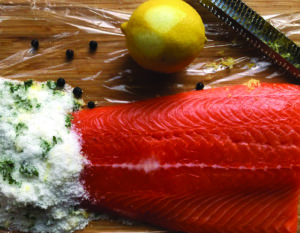I didn’t grow up eating salmon, although when we were kids, my grandfather did teach us how to smoke it. That was something he learned on his fishing trips to the Miramichi River in New Brunswick, Canada. It wasn’t until later, when I had a job in New York, that I learned about lox. That’s one of the things I’ll always crave when I think about the city where the Yiddish word for salmon has come to define the brine-cured version.
It’s not easy to find an excellent bagel out here, though I’ve heard promising reports of quests to create one. And, though it’s not local, it is possible to source good salmon. Curing it is sure simple. Especially the Nordic version of the cure: gravlax, made with equal parts salt and sugar, and lots of fresh dill. As long as you keep those salt and sugar proportions steady, you can vary the flavorings — my “house” recipe includes lemon zest, mint, and a little gin.
We get wild salmon from Alaska, usually in mid-summer to fall, and it is one of my special-occasion favorites. But curing dries the fish somewhat, so I actually like the fat content of Scottish farmed salmon for making gravlax.
Why isn’t it local? Because our native salmon lost its spawning habitat early on in the industrialization of America’s East Coast. There are a few places where salmon are seen, but commercial fishing of Atlantic salmon has long been prohibited.
When we first started selling salmon in the markets, the farmed fish came from Chile and was notorious for being treated with antibiotics and growth hormones. We didn’t want to carry it. But now there are some sources of sustainably farmed salmon. What’s super important is low feed-to-fish ratios.
Even with the richer Scottish salmon, the longer you leave it in the cure, the drier and more intense the flavorings will be. I like to go just 24 to 36 hours. After all, we’re not using this cure for long storage, but for flavor and texture — thin slices of gravlax that seem to melt in your mouth.

Mac’s House Gravlax
A 2-3 lb. salmon fillet
2 cups kosher salt
2 cups sugar
4 lemons, zest only
1 bunch mint, minced
1 small bunch dill, minced
2 Tbsp. gin
1 Tbsp. juniper berries (optional)
Place the salmon skin side down on a long sheet of plastic wrap — long enough to later wrap over the fish lengthwise. Feel the fillet for the “pin bones” that run down the middle of the fillet and pull them out. This will make the gravlax easier to slice neatly. Set the fish, still on the wrap, in a ceramic or glass dish.
Combine everything else in a bowl: the salt, sugar, zest, herbs, juniper berries, and gin. Then cover the flesh side of the salmon with the sugar-salt mixture. It might seem like a lot, but pile it all on evenly, covering the fillet well. Wrap the plastic over the top. I like to gently press the salmon by putting a cutting board on top, stacked with a couple of cans of tomatoes for weight. I think it helps create a firmer texture.
Leave the fillet in a cool spot in your kitchen for a few hours, so the cure begins melting, then put it in the refrigerator to cure for 24 to 36 hours.
Unwrap the fish and wipe off the cure with the back side of a knife or spoon. Slice at an angle, as thin as possible, and serve. The finished gravlax can also be kept in the refrigerator for at least a week if it’s well-wrapped, so it won’t dry out.



